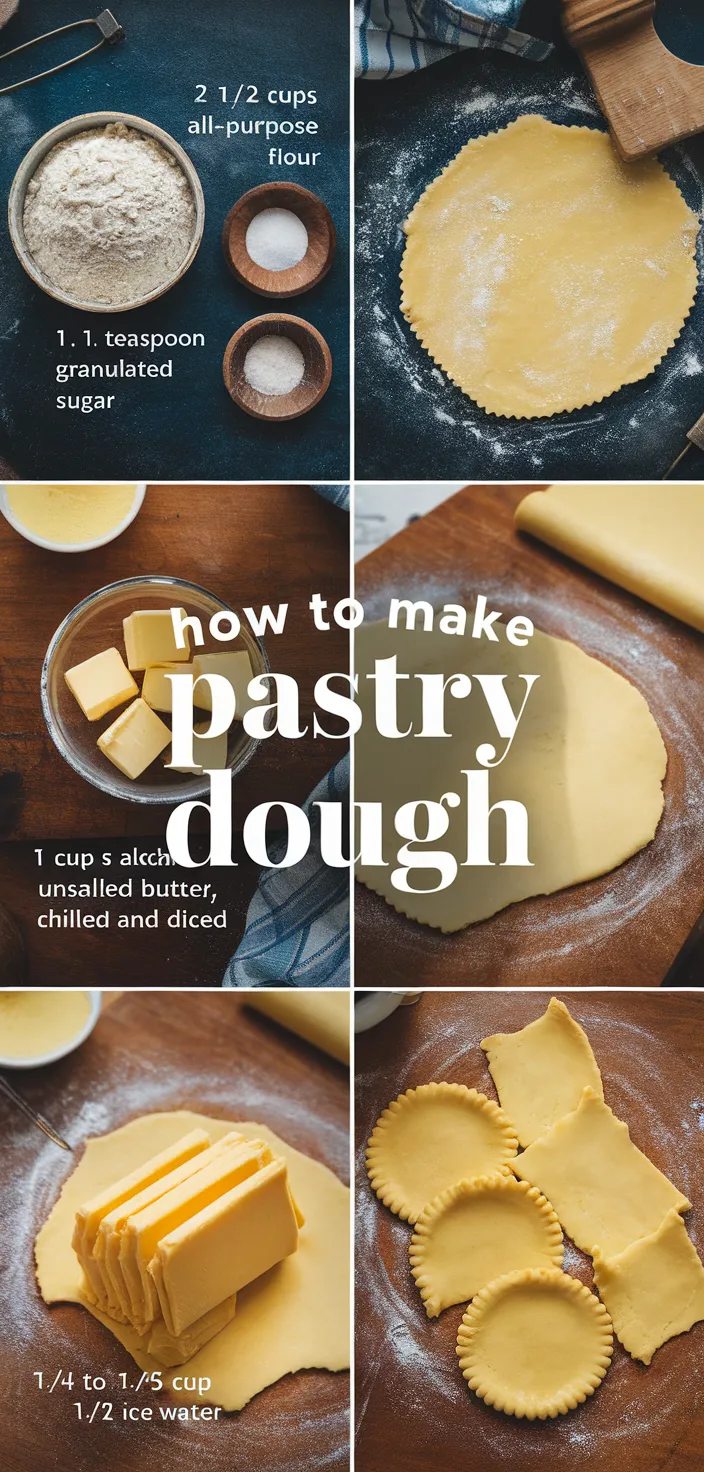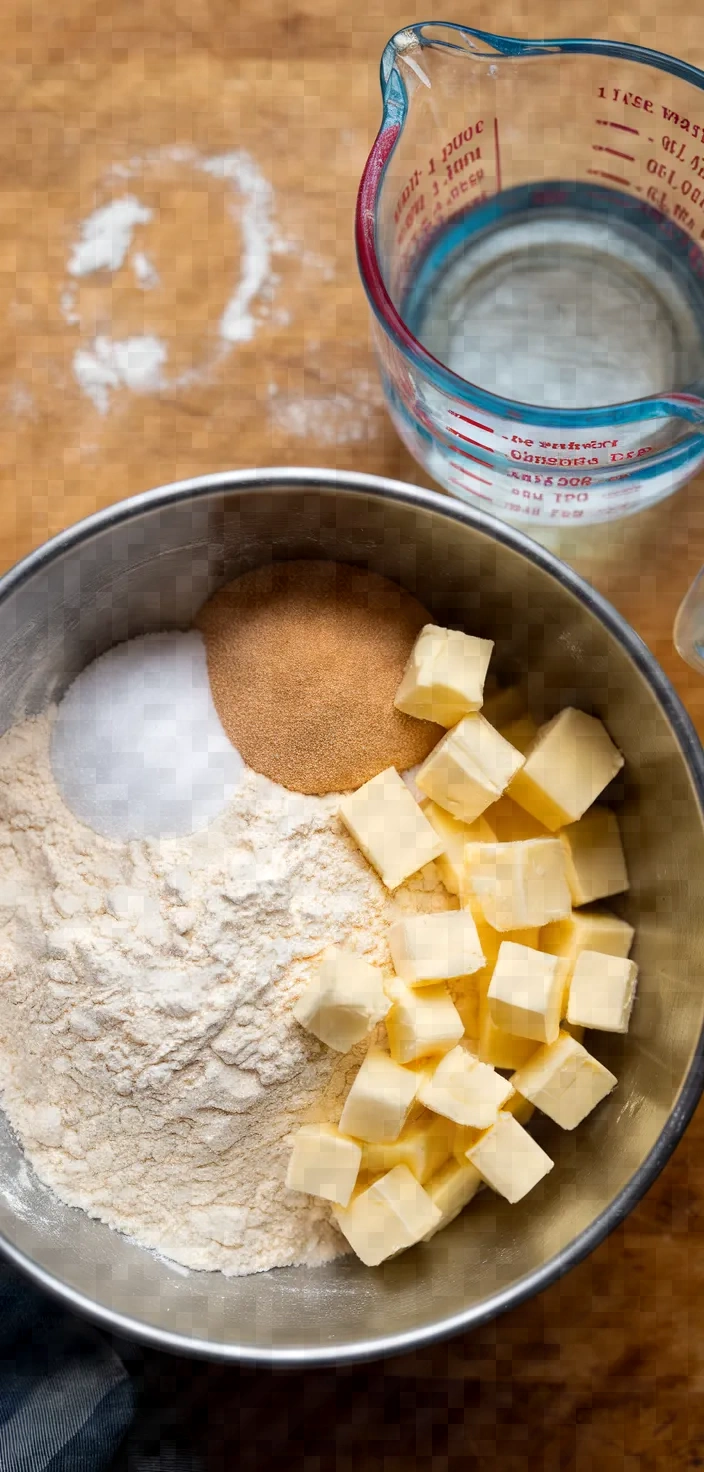In the kitchen, I treasure creating the perfect pastry dough. The satisfaction of a flaky, buttery crust that melts in your mouth is hard to beat.
This simple recipe uses just a handful of ingredients to bring that experience to life. You begin with 2 1/2 cups of all-purpose flour, which gives a versatile base that serves as the backbone of the dough.
I add 1 teaspoon of salt to really make the flavors sing and 1 tablespoon of granulated sugar for a touch of sweetness that nicely balances all the savory richness. Here, 1 cup of unsalted butter, chilled and diced, takes center stage.
Using cold butter is crucial; it helps achieve those flake-alicious layers. Diced butter creates pockets of steam as it bakes, and the dough rises.
Baked to golden perfection, this dish is a masterpiece of flavor and presentation. In the end, I add 1/4 to 1/2 cup of ice water to hold everything together.
With the ice water, I get precise control over the dough’s moisture and can easily achieve the right balance. When it comes to the dough’s versatility, you can’t go wrong with this recipe as a foundation for both sweet and savory dishes.
Once you’ve made the dough, you can use it to showcase simple, quality ingredients.

Ingredients

All-purpose flour: Rich in carbs, it gives the dough structure.
Salt: Boosts flavor, harmonizes sweetness, indispensable for taste.
Sugar granules: Contribute just a touch of sweetness and assist in the browning process.
Butter without salt: Contributes richness, a flaky texture, and flavor that is deep.
Water for ice: Adjusts dough consistency, keeps butter from melting.
Ingredient Quantities
- 2 1/2 cups all-purpose flour
- 1 teaspoon salt
- 1 tablespoon granulated sugar
- 1 cup unsalted butter, chilled and diced
- 1/4 to 1/2 cup ice water
Instructions
1. In a big mixing bowl, thoroughly combine the flour, salt, and granulated sugar; it’s best to whisk them together until you can no longer see or feel any of the individual ingredients.
2. Ensure that the very cold butter is diced and mixed into the flour mixture. Use a pastry cutter or your fingertips to blend the butter into the flour mixture until it resembles coarse crumbs with small, pea-sized lumps of butter.
3. Slowly incorporate the ice water, beginning with 1/4 cup and adding it in a very gradual manner, while mixing with a fork or my hands. I mix until the dough starts to come together. If needed, I add more water, using a tablespoon at a time, until the dough comes together nicely.
4. Move the dough to a surface that is only lightly floured. Knead the dough just enough to make a cohesive ball, and don’t overdo it. It should take only a minute or so. Kneading is a rhythmic motion: push down into the dough with the heel of one hand while folding the dough toward you with the other hand. After you push down, turn the dough a quarter turn and repeat.
5. Split the dough into two equal parts, shape each into a disc, and wrap them individually in plastic wrap.
6. Chill the dough for a minimum of 1 hour or up to overnight to allow the gluten to relax and the dough to firm up.
7. When you are ready to use it, remove the dough from the refrigerator and let it sit at room temperature for a few minutes. This will make the dough pliable again.
8. Dust the surface where you will be working, and the rolling pin, lightly with flour. Roll each dough disc out to the thickness and size you want for the pastries you are making.
9. With great care, move the flattened dough to a dish or platter and into the shape of a pie, patting it into place before adding the beaten eggs, cream, and seasonings.
10. Remove any extra dough, then follow your particular recipe for blind baking, or filling and baking, as needed.
Equipment Needed
1. Large mixing bowl
2. Whisk
3. Pastry cutter or fingertips
4. Measuring cups
5. Measuring spoons
6. Fork or your hands for mixing
7. Lightly floured surface
8. Plastic wrap
9. Rolling pin
10. Dish or platter for shaping pie
11. Knife or kitchen shears (to remove any extra dough)
FAQ
- Can I use salted butter instead of unsalted butter?Yes, you can use salted butter, but reduce the added salt to 1/2 teaspoon to avoid over-salting the dough.
- Is it necessary to use ice water?Keeping the butter solid while mixing is important for achieving a flakier pastry, and using ice water helps with that. It’s all but a requirement if you want a pastry that’s lighter and flakier.
- Can I make the pastry dough ahead of time?Undoubtedly, you can mix up the dough, enclose it in plastic wrap, and chill it in the refrigerator for as long as 3 days, or you can store it in the freezer for up to a month.
- What if I don’t have a food processor?Using either a pastry cutter or your hands, you can incorporate the butter into the flour until the mixture looks like coarse crumbs.
- How do I know if I’ve added enough water?The dough ought to assemble easily but not be adhesive. Introduce water slowly, one tablespoon at a time, until it retains the shape when squished.
- Can I make this dough gluten-free?Indeed, replace all-purpose flour with a gluten-free flour blend that has xanthan gum in it to bind the ingredients.
- What type of recipes can I use this pastry dough for?This adaptable dough can be used for tarts, pies, quiches, and other dishes made with pastry.
Substitutions and Variations
All-purpose flour: Use whole wheat flour or gluten-free all-purpose flour to accommodate different textures or dietary requirements.
Butter, unsalted: Replace with margarine or chilled coconut oil for a dairy-free alternative.
Granulated sugar: Substitute coconut sugar or honey for a natural sweetener alternative.
Chilling agents: For a richer and more flavorful drink, consider using cold milk or a non-dairy milk.










